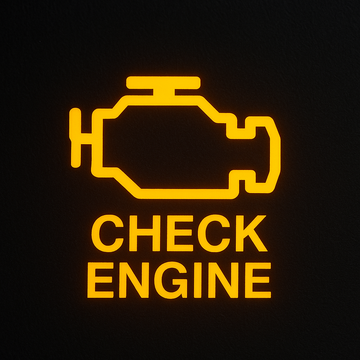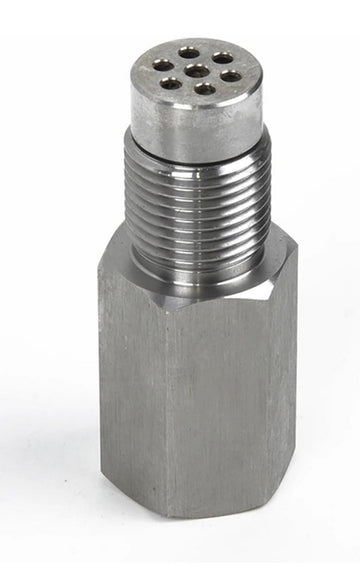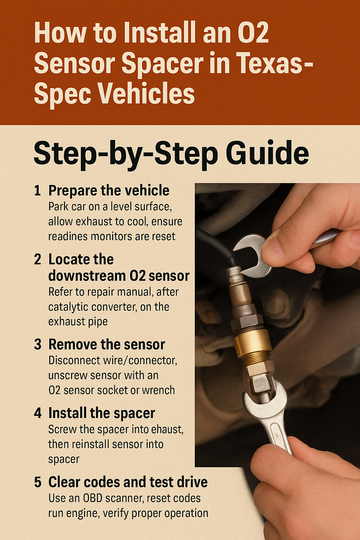Summary
A failing catalytic converter can cripple your vehicle’s performance, increase emissions, and trigger the check engine light. Fortunately, your vehicle's oxygen (O2) sensors play a critical role in detecting catalytic converter issues before they lead to costly repairs. In this article, we explain the symptoms of a bad catalytic converter, how O2 sensors monitor its efficiency, and how they can help you diagnose (and sometimes bypass) the issue effectively.
Table of Contents
-
What Does a Catalytic Converter Do?
-
Common Signs of a Bad Catalytic Converter
-
How O2 Sensors Monitor the Catalytic Converter
-
Upstream vs Downstream O2 Sensors: What's the Difference?
-
Diagnosing Catalytic Converter Issues with O2 Sensor Data
-
Can a Bad O2 Sensor Mimic a Bad Catalytic Converter?
-
Using O2 Sensor Spacers to Bypass Converter Codes
-
When to Replace vs When to Repair
-
Frequently Asked Questions (FAQ)
1. What Does a Catalytic Converter Do?
A catalytic converter is part of your vehicle's exhaust system that reduces harmful emissions. It converts carbon monoxide, hydrocarbons, and nitrogen oxides into less harmful gases like carbon dioxide and water vapor using precious metals like platinum, palladium, and rhodium.
2. Common Signs of a Bad Catalytic Converter
-
Check Engine Light On (CEL)
-
Sulfur or Rotten Egg Smell
-
Poor Acceleration or Engine Power Loss
-
Increased Emissions or Failed Smog Test
-
Excessive Heat Under the Vehicle
-
Reduced Fuel Efficiency
3. How O2 Sensors Monitor the Catalytic Converter
Your vehicle typically has two types of O2 sensors:
-
Upstream (Pre-Cat): Located before the catalytic converter; monitors raw exhaust gases.
-
Downstream (Post-Cat): Located after the converter; checks the efficiency of the catalytic reaction.
By comparing data from both sensors, the engine control unit (ECU) can tell whether the catalytic converter is doing its job effectively.
4. Upstream vs Downstream O2 Sensors
-
Upstream Sensor (Sensor 1): Helps manage air-fuel ratio.
-
Downstream Sensor (Sensor 2): Detects how well the catalytic converter is cleaning the exhaust gases.
If both sensors report similar voltage patterns, it usually means the catalytic converter isn’t working properly.
5. Diagnosing Catalytic Converter Issues with O2 Sensor Data
Modern vehicles allow access to live O2 sensor readings via OBD2 scanners. Here’s what to look for:
-
Upstream Sensor: Should fluctuate rapidly between 0.1–0.9V (rich and lean conditions).
-
Downstream Sensor: Should stay relatively stable if the converter is working. If it mimics the upstream sensor, the converter is likely degraded.
Some common diagnostic trouble codes (DTCs) related to the catalytic converter:
-
P0420 – Catalyst System Efficiency Below Threshold (Bank 1)
-
P0430 – Catalyst System Efficiency Below Threshold (Bank 2)
6. Can a Bad O2 Sensor Mimic a Bad Catalytic Converter?
Absolutely. A failing O2 sensor can give false readings that trick your ECU into thinking the converter has failed. That’s why it’s important to:
-
Rule out a bad O2 sensor before replacing the catalytic converter
-
Check for DTCs related to sensor voltage or heater circuit faults (e.g., P0136, P0141)
7. Using O2 Sensor Spacers to Bypass Converter Codes
While not a true "fix," O2 sensor spacers (also known as extenders or defoulers) are often used in the aftermarket scene to:
-
Reduce sensitivity of the downstream O2 sensor
-
Prevent the check engine light when running high-flow or test pipes
-
"Trick" the ECU into thinking the catalytic converter is working properly
⚠️ Important Note: Using O2 sensor spacers to defeat emissions systems may be illegal in your area. Always check local emissions laws.
8. When to Replace vs When to Repair
If diagnostics confirm your catalytic converter is faulty:
-
Replace it if it's melted, clogged, or failed internally.
-
Clean it only if it's lightly carbon-fouled and still structurally sound (not always effective).
-
Rule out engine issues (like misfiring or oil burning) that may have caused premature failure.
9. Frequently Asked Questions (FAQ)
❓ Can I drive with a bad catalytic converter?
Yes, but performance and fuel economy will suffer, and it may damage your engine or fail emissions tests.
❓ Will a bad catalytic converter damage my O2 sensors?
Yes. If it’s running too hot or releasing contaminants, it can burn out or foul downstream O2 sensors.
❓ Will an O2 sensor spacer fix a bad catalytic converter?
No, it won’t fix the converter, but it may suppress the related error code temporarily. This is not a legal solution for road use in most areas.
❓ How long do catalytic converters and O2 sensors last?
-
Catalytic converters: 70,000 to 100,000+ miles
-
O2 sensors: 60,000 to 90,000 miles (upstream usually fails first)


![ Fix P0420 Fast: Do O2 Sensor Spacers Really Work? [Legal Tips Inside]](http://ghalysmotorparts.com/cdn/shop/articles/ChatGPT_Image_Oct_10_2025_10_40_32_AM.png?v=1760118069&width=360)
![Do O2 Sensor Spacers Really Help Clear the P0420 Code? [Expert Guide]](http://ghalysmotorparts.com/cdn/shop/articles/ChatGPT_Image_Oct_9_2025_09_28_33_PM_654c1798-c0d4-428f-a5b6-f20b95661b54.png?v=1760129952&width=360)


